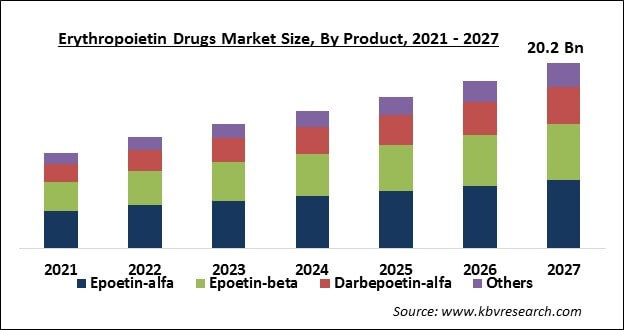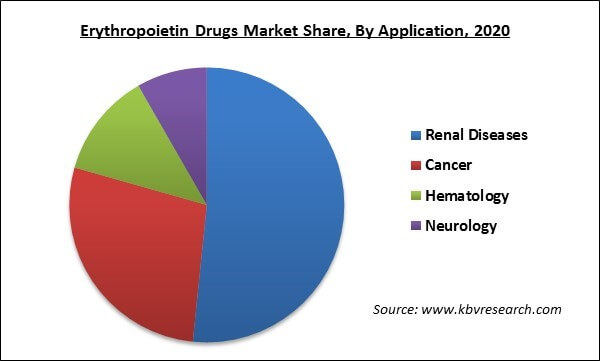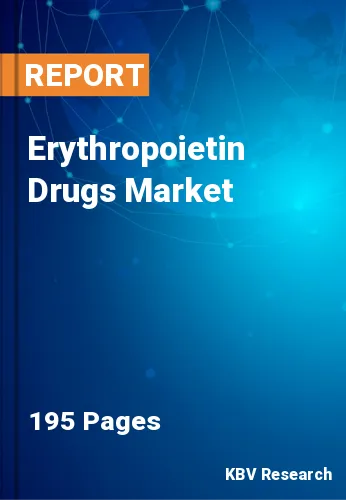The Global Erythropoietin Drugs Market size is expected to reach $20.2 billion by 2027, rising at a market growth of 11.8% CAGR during the forecast period. Erythropoietin (EPO) also called hematopoietin is a glycoprotein hormone. It stimulates the process of erythropoiesis which results in the production of red blood cells in the bone marrow. The main goal for the development of erythropoietin drug was to treat anaemic conditions arising from end-stage renal disease (ESRD) disease. Thus, it helps in treatments of this disease and dialysis procedures. Apart from its use in ESRD anaemic conditions, erythropoietin drugs also received approvals for chemotherapy-induced anaemia. The post-abbreviated new drug application (ANDA) is getting approvals and there is a high success rate of erythropoietin drugs in chemotherapy-induced anaemia. Due to all these factors, major biopharmaceutical companies turned their focus towards another form of induced anaemia, that is ART-induced anaemia which occurs mostly among the HIV patients.
Epoetin alfa (Epoge) is a kind of recombinant erythropoietin that was developed by Amgen Inc. in 1983. It was the first rhEPO that was commercialized in the United States, after alfa and beta formulations. Epoetin refers to an erythropoiesis-stimulating glycoprotein that is composed of a 165-amino acid. It is produced in cell culture based on recombinant DNA technology. This drug is used to treat patients suffering from anaemia and other blood-related clinical conditions like chronic renal failure, chemotherapy, and antiviral drug therapy. This drug is also recommended for patients who are at high risk for perioperative blood loss due to surgical procedures.

The COVID-19 resulted in the disruption of workflows in the health care sector across the world. A number of industries were forced to go for shutdown temporarily due to this outbreak. The main affected industry is the sub-domains of health care. Yet, it has positively affected the demand for medicines and increased the demand for several medical services, such as erythropoietin. The erythropoietin (EPO) drug is used to treat anaemia and works effectively against COVID-19. This has been scientifically proved by scientists of the Max Planck Institute of Experimental Medicine in Gottingen. According to the research, the SARS-CoV-2 potentially attacks the brain, and erythropoietin can diminish serious disease development. Thus, it can protect people from the development of long-term neurological problems.
However, EPO is beneficial in many other diseases and has cytoprotective effects such as regenerative, anti-ischemic, and anti-apoptotic effects in tissues like lung, kidney, cardiac muscle, retina, pancreas, nervous system, and endothelial cells. Therefore, the impact of the COVID-19 pandemic is likely to have a positive impact on the erythropoietin drug market.
Based on Drug Class, the market is segmented into Biologics and Biosimilars. Based on Drug Class, the biologics erythropoietin segment dominated the market in 2020 because of the patent protection. Other factors driving the growth of this segment include the presence of a large patient population and increased uptake of biologics in various diseases. The availability of very few biologics in the market resulted in higher adoption of this drug.
Based on Product, the market is segmented into Epoetin-alfa, Epoetin-beta, Darbepoetin-alfa and others. Epoetin-beta is a recombinant type of drug formed from epoetin-alfa. This product segment is growing owing to its benefits like improved efficacy and a longer half-life compared to the epoetin-alfa. Darbepoetin-alfa is also a novel erythropoietin drug. It is developed by Amgen, Inc., marketed under the brand name Aranesp. Darbepoetin-alfa segment is likely to see positive growth during the forecast period. It is accredited to its higher efficacy, cost-effectiveness, and longer half-life. It is considered a feasible solution for the treatment of anaemia arising due to end-stage renal diseases.

Based on Application, the market is segmented into Renal Diseases, Cancer, Hematology and Neurology. The cancer segment would showcase fastest growth rate during the forecast period. It is due to the increasing cases of cancer incidence across the world. Cancer chemotherapy includes the utilization of medication which is capable of increasing the RBC count amongst patients. Thus, the usage of such drugs for chemotherapy has gained considerable attention in recent years. This has increased the demand for EPO drugs for cancer treatment that will act as a positive factor to augment the growth of this segment.
| Report Attribute | Details |
|---|---|
| Market size value in 2020 | USD 8.7 Billion |
| Market size forecast in 2027 | USD 20.2 Billion |
| Base Year | 2020 |
| Historical Period | 2017 to 2019 |
| Forecast Period | 2021 to 2027 |
| Revenue Growth Rate | CAGR of 11.8% from 2021 to 2027 |
| Number of Pages | 195 |
| Number of Tables | 360 |
| Report coverage | Market Trends, Revenue Estimation and Forecast, Segmentation Analysis, Regional and Country Breakdown, Companies Strategic Developments, Company Profiling |
| Segments covered | Drug Class, Product, Application, Region |
| Country scope | US, Canada, Mexico, Germany, UK, France, Russia, Spain, Italy, China, Japan, India, South Korea, Singapore, Malaysia, Brazil, Argentina, UAE, Saudi Arabia, South Africa, Nigeria |
| Growth Drivers |
|
| Restraints |
|
Based on Regions, the market is segmented into North America, Europe, Asia Pacific, and Latin America, Middle East & Africa. North America emerged as one of the dominating regions of the global market by. It is accredited to the factors like the increasing incidence of chronic diseases including cancer, CKD, and HIV. As per data by the Centers for Disease Control and Prevention (CDC), there are 1.2 million people in the U.S. who are living with HIV and more than 39,000 cases were detected in 2015. These statistics are a clear indication that the demand for EPO drugs will increase over the forecast period.
Free Valuable Insights: Global Erythropoietin Drugs Market size to reach USD 20.2 Billion by 2027
The market research report covers the analysis of key stake holders of the market. Key companies profiled in the report include Johnson and Johnson, Teva Pharmaceuticals Industries Ltd., Amgen, Inc., F. Hoffmann-La Roche Ltd., Biocon Limited, Intas Pharmaceutical Ltd., Sun Pharmaceutical Industries Ltd., Dr. Reddy’s Laboratories Ltd., LG Corporation (LG Life Sciences Ltd.), and Celltrion, Inc.
By Drug Class
By Product
By Application
By Geography
The global erythropoietin drugs market size is expected to reach $20.2 billion by 2027.
Increasing usage of erythropoietin drugs in the treatment of anaemia are driving the market in coming years, however, high cost of the erythropoietin drug have limited the growth of the market.
Johnson and Johnson, Teva Pharmaceuticals Industries Ltd., Amgen, Inc., F. Hoffmann-La Roche Ltd., Biocon Limited, Intas Pharmaceutical Ltd., Sun Pharmaceutical Industries Ltd., Dr. Reddy’s Laboratories Ltd., LG Corporation (LG Life Sciences Ltd.), and Celltrion, Inc.
A number of industries were forced to go for shutdown temporarily due to this outbreak. The main affected industry is the sub-domains of health care. Yet, it has positively affected the demand for medicines and increased the demand for several medical services, such as erythropoietin.
The 32GB–64GB market dominated the Global erythropoietin drugs Market by Density 2020, thereby, achieving a market value of $5,337.1 million by 2027.
.The North America market dominated the Global Erythropoietin Drugs Market by Region in 2020.
Our team of dedicated experts can provide you with attractive expansion opportunities for your business.

